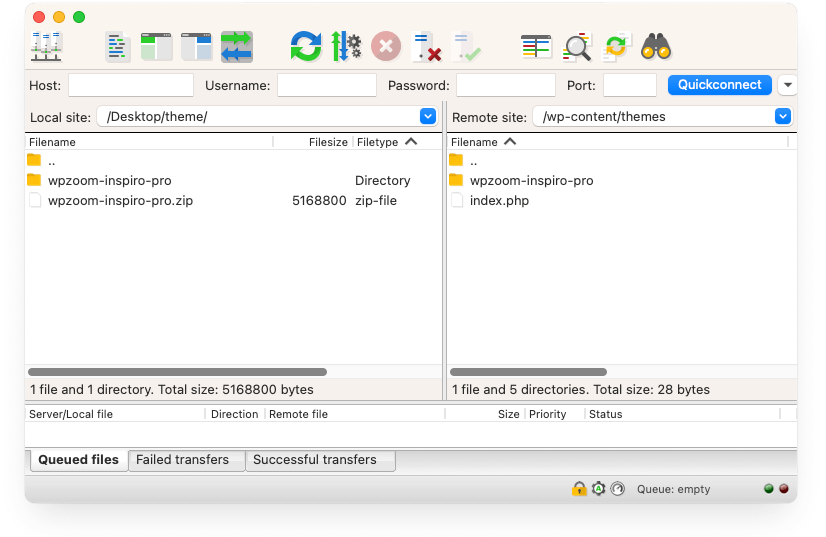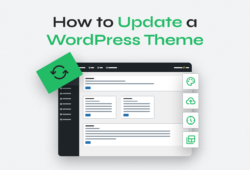
New to WordPress and unsure how to delete a theme in WordPress? Don’t worry, you’re not alone. Unused themes can cause various issues, but removing them is easier than you might think.
In this guide, we’ll show you the essential steps to safely remove unused themes, helping you keep your site streamlined and secure.
Table of Contents
- Why Should You Delete WordPress Themes?
- Before You Delete a WordPress Theme
- How to Delete a Theme in WordPress
- After Your Delete a Theme from WordPress
- When Not to Remove a WordPress Theme
Why Should You Delete WordPress Themes?
When managing a WordPress site, deciding to delete a theme isn’t always straightforward, but it’s an essential step in certain situations. Here are the main reasons why you should consider deleting unused WordPress themes:
- Security Issues: Unused themes, especially those not regularly updated, can become security vulnerabilities. Hackers often exploit outdated themes to gain access to your site. Removing these themes reduces potential entry points for cyber threats.
- Improved Performance: Every theme, whether active or inactive, takes up server space. By deleting unused themes, you free up valuable resources, leading to better site performance and faster load times. A leaner website is more efficient and provides a better user experience.
- Avoid Compatibility Problems: Themes that are no longer updated by their developers can cause compatibility issues with the latest WordPress updates or your installed plugins. Outdated themes might disrupt your site’s functionality, causing errors and glitches.
- Organizational Clarity: Keeping only the themes you actively use helps maintain a cleaner, more organized WordPress dashboard. This makes site management more straightforward and less confusing, allowing you to focus on what’s important.
- Database Optimization: Unnecessary themes can bloat your WordPress database, slowing down your site. Deleting these themes helps streamline your database, ensuring quicker load times and a more responsive site.
- Problem Resolution: Sometimes, inactive themes can conflict with active themes or plugins, causing site issues. Deleting these unused themes can help resolve such conflicts and improve site stability.
Before You Delete a WordPress Theme
Before you jump into deleting themes in WordPress, it’s important to take a few preparatory steps. These actions ensure that your website remains stable and you don’t lose any valuable data. Here’s what you need to consider:
- Back Up the Theme and Customizations: Before removing any theme, it’s crucial to back up the theme files and any customizations you’ve made. This step is essential in case you need to revert or retrieve specific design elements or functions later.
- Check for Child Themes: If you’re using a child theme (a theme that inherits functionalities from another theme, known as the parent theme), ensure that deleting the parent theme won’t affect your site’s performance. Deleting a parent theme while there is an active child theme can lead to broken designs and functionalities. Verify that the child theme will function correctly without the parent theme.
- Review Theme Dependencies: Some WordPress themes may have dependencies, such as specific plugins or settings that your site relies on. Review these dependencies to ensure that removing the theme doesn’t disrupt other aspects of your website. Check your theme documentation or support forums to identify any potential dependencies.
- Understand Deleting vs. Uninstalling: It’s crucial to understand the difference between deleting and uninstalling a theme. Deleting a theme removes it from your WordPress installation, while uninstalling a theme might involve additional steps, like removing settings and options specific to that theme. Make sure you follow the correct procedure to avoid leaving behind residual data.
- Activate a Different Theme: If you plan to delete your currently active theme, you must first activate a different theme. The delete option won’t appear for an active theme. Choose and activate an alternative theme before proceeding with the deletion process.
How to Delete a Theme in WordPress: 3 Methods
Deleting an unused theme from your WordPress website can be done in several ways, depending on your preference and access level. Here, we’ll cover the three most common methods: through the WordPress Dashboard, via FTP, and using the cPanel. Follow these step-by-step instructions to safely and effectively remove unwanted themes from your WordPress site.
Method 1: Remove the Theme From WordPress Dashboard
The WordPress Dashboard offers the simplest and most user-friendly way to delete a theme. This method is ideal for users who prefer a graphical interface and want to manage their themes directly within the WordPress environment. Follow these steps to safely remove an unused theme from your WordPress site:
- Log in to your WordPress Dashboard by entering your username and password.
- In the left-hand menu, navigate to Appearance > Themes. You will see a list of all the themes currently installed on your site.
- Hover over the theme you want to remove. Ensure it is an inactive theme, as you cannot delete the currently active theme. Click on the Theme Details button that appears.
- In the bottom-right corner of the theme details window, click the Delete button. A confirmation prompt will appear. Click OK to confirm the deletion. The theme will be removed from your site.
Note: If you plan to delete your currently active theme, you must first activate a different theme. The delete option will not be available for an active theme.
Method 2: Delete the Theme Via FTP
For those who are comfortable with more technical approaches, deleting a theme via FTP (File Transfer Protocol) offers a direct way to manage your site’s files. This method is particularly useful when you cannot access the WordPress Dashboard due to errors or restrictions. Here’s how to delete a theme using FTP:
- Download and install an FTP client like FileZilla. Open FileZilla and enter your FTP credentials (host, username, password, and port) to connect to your server. These credentials are usually provided by your web hosting service.
- Once connected, navigate to the root directory of your WordPress installation. This is typically the /public_html/ or /www/ directory. Open the /wp-content/ folder, and then open the /themes/ folder. Here, you will find folders for each theme installed on your site.
- Identify the folder of the theme you wish to delete. Ensure you are selecting the correct theme folder. Right-click on the theme folder and select Delete. Confirm the deletion when prompted. This action will permanently remove the theme files from your server.
Method 3: Remove the WordPress Theme Via cPanel/Hosting Panel
The cPanel or hosting panel method is another effective way to delete a WordPress theme, especially useful for users who have hosting account access and are familiar with cPanel functionalities. This approach allows you to manage theme files directly on the server, offering a balance between ease of use and direct file management capabilities. Follow these steps to delete a theme using cPanel:
- Log in to your web hosting account. Most hosting providers offer a cPanel or similar hosting control panel for managing your site. Navigate to the cPanel dashboard.
- In the cPanel dashboard, locate and click on the File Manager icon. This tool allows you to manage your website files directly on the server.
In the File Manager, navigate to the root directory of your WordPress installation. This is usually found under /public_html/ or /www/. - In the root directory, open the /wp-content/ folder, then open the /themes/ folder. Here, you will see a list of folders for each theme installed on your site.
- Identify the folder of the theme you wish to delete. Make sure you are selecting the correct theme folder to avoid accidental deletion of important themes. Right-click on the theme folder and select Delete. Confirm the deletion when prompted. This action will permanently remove the theme files from your server.
Each of these methods effectively removes the theme from your WordPress site. Choose the method that best suits your comfort level and access rights.
After Your Delete a Theme from WordPress
After successfully deleting a WordPress theme, it’s important to take a few additional steps to ensure your site remains clean and efficient. These post-deletion actions help remove any residual data the deleted theme might have left behind, optimizing your site’s performance and organization.
- Delete Unused Images: Themes often come with specific images, such as backgrounds, headers, or icons. Navigate to the Media Library in your WordPress dashboard and remove any images associated with the deleted theme. This helps free up storage space and keeps your media library organized.
- Remove Theme-Specific Menus: Some themes create custom menus or modify existing ones. Go to Appearance > Menus and review the menus. Delete any that were specific to the deleted theme or are no longer needed to maintain a streamlined navigation setup.
- Clean Up Widgets: Themes often add specific widgets that might no longer function properly or be relevant after the theme is deleted. Visit the Widgets section under Appearance in your dashboard and remove any unnecessary or inactive widgets.
- Delete Dummy Content: If your deleted theme included dummy content like posts, pages, or custom post types, it’s a good idea to clean these up to avoid clutter. Go through your content and remove any items that were added by the theme and are no longer needed.
- Optimize Your Database: Residual data from deleted themes can bloat your WordPress database, slowing down your site. Use a database optimization plugin to clean up and optimize your database, ensuring better performance and quicker load times.
- Review and Adjust Settings: Some themes add specific settings or options within your WordPress dashboard. Check your settings pages and remove or adjust any options that are no longer relevant. This helps avoid conflicts and ensures your site is configured correctly.
- Test Your Site: After making these changes, thoroughly test your site to ensure everything is functioning correctly. Check for broken links, missing images, or layout issues that might have resulted from the theme deletion.
When Not to Remove a WordPress Theme
In some scenarios, deleting a WordPress theme might not be the best course of action. Being aware of these situations can save you from potential headaches and keep your site running smoothly. Here are some instances when you should think twice before deleting a theme:
- Active Parent Themes: If you’re using a child theme, it relies on the parent theme for its functionality and design. Deleting a parent theme while a child theme is active can break your site’s layout and functionalities. Always ensure no active child themes depend on the theme you plan to delete.
- Multisite Installations: In WordPress multisite installations, a theme might be used across different sites within the network. Deleting a theme that’s in use by another site can lead to issues on that site. Verify the theme’s usage across the network before proceeding with deletion.
- Staging or Testing Environments: Maintaining various themes in staging or testing environments can be beneficial for testing compatibility and updates. Deleting themes in these environments can limit your testing capabilities and potentially disrupt your workflow.
- Legacy Support or Future Use: Sometimes, you might want to keep older themes for legacy reasons or potential future use. If a theme holds sentimental value, specific customizations, or might be reused for inspiration or reactivation, it’s worth keeping. Consider updating and maintaining these themes instead of deleting them.
- Troubleshooting and Backup: If you’re troubleshooting an issue or need a backup theme in case of emergencies, keeping a few additional themes can be useful. Having a fallback theme ready can help quickly resolve issues if your primary theme encounters problems.
In these cases, rather than deleting, consider other options like updating the theme or troubleshooting issues to ensure it remains a valuable part of your WordPress toolkit.
Bottom Line
Successfully managing your WordPress site involves making informed decisions about theme management, including when and how to delete themes. Deleting a WordPress theme should be a thoughtful decision, considering its impact on your site’s security, performance, and appearance.
Unused themes can pose security risks, slow down your site, and take up valuable storage space. By following this comprehensive guide, you can confidently delete unnecessary themes, optimize your site’s performance, and maintain a secure and efficient WordPress environment.









